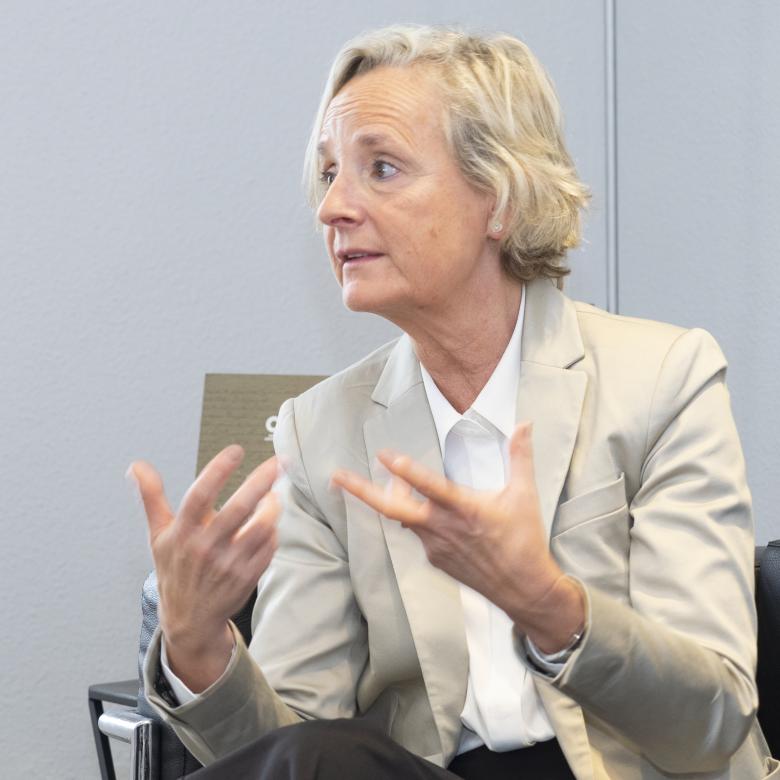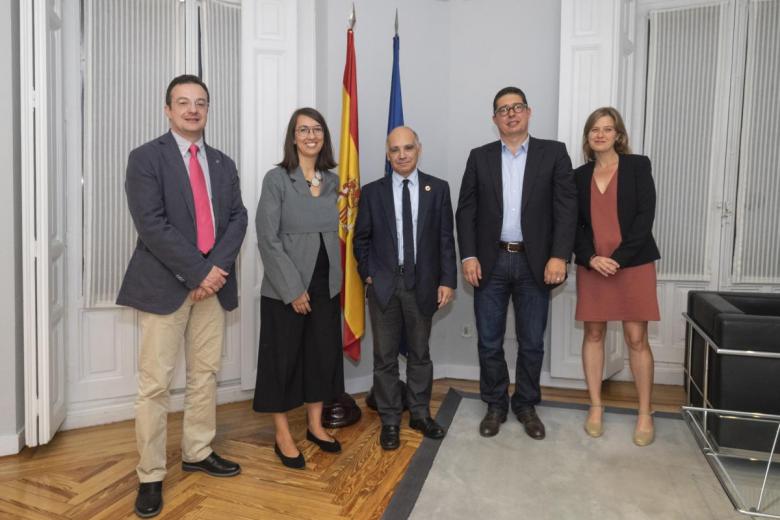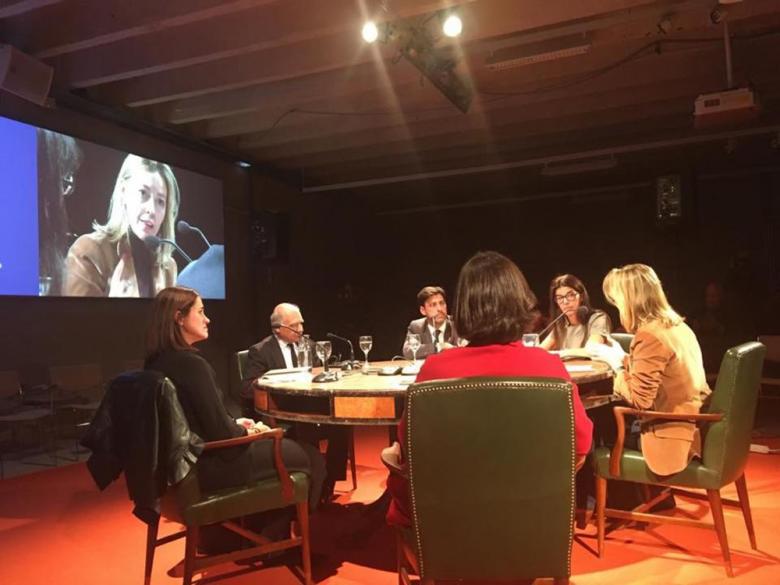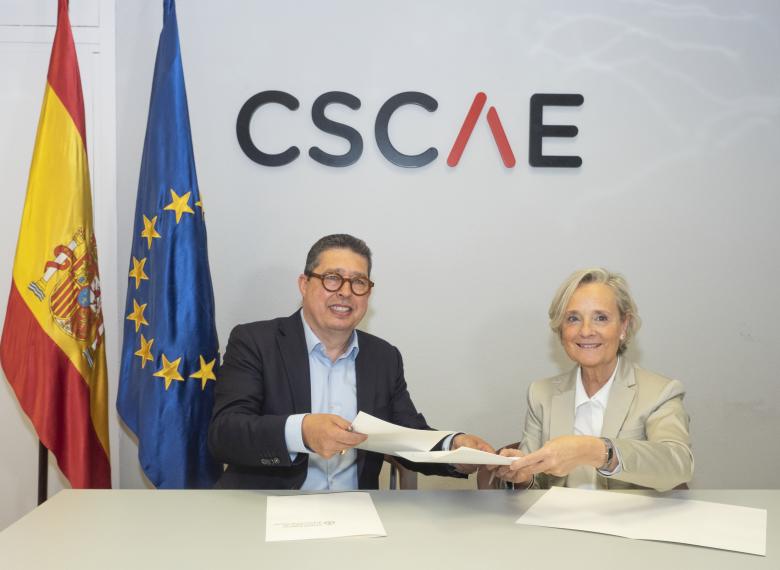Interview with Marta Vall-llossera Ferran, president of the Superior Council of Architects’ Associations in Spain
Fighting Global Warming and a Lack of Affordable Housing
Madeline Beach Carey
10. November 2023
Marta Vall-llossera Ferran, CSCAE President (Photo © Ricardo Marquerie)
Marta Vall-llossera Ferran became the president of the Superior Council of Architects’ Associations in Spain (CSCAE) after the sudden death of her predecessor Lluís Comerón in 2022. Madeline Beach Carey spoke with Vall-llossera Ferran about her challenges as president, the crises Spain is facing, and the role of architects in addressing those crises. Their conversation has been edited for length and clarity.
Madeline Beach Carey (MBC): After this first year as president of the Council what have you found most challenging?
Marta Vall-llossera Ferran (MVF): In a context in which the advance of climate change and its effects are becoming more and more evident, and with an energy crisis that has increased the prices of electricity and gas, the integral renovation of homes constitutes the most important opportunity that cities have to move towards a better future, making our buildings more efficient, autonomous, and sustainable.
In Spain, 55% of the homes that make up the building stock were built before 1980, when the first regulations establishing minimum energy efficiency standards were approved. There are about 10 million homes. However, the pace of renovation is insufficient in order to meet the EU decarbonization targets for 2030 and 2050.
In a country where barely 30,000 homes are renovated a year, the wave of rehabilitation of homes and buildings promoted within the Recovery, Transformation and Resilience Plan as part of the NextGenerationEU funds contemplates 510,000 interventions by 2026. It is a historic opportunity, but the management of the funds and the execution of this “wave of renewal,” with a comprehensive view that optimizes resources and responds to the needs of the population in the short, medium and long terms, is the hardest challenge we have — and not only as a profession, but as a country. A national priority!
L-R: Laureano Matas, Miriam Giordano, Lluís Comerón, Renato Turri, and Madeline Beach Carey in 2018 on the occasion of the signing of the agreement between CSCAE and World-Architects. (Photo © Nfoca)
MBC: In 2022, in a plenary session, the Council instituted an award in honor of Lluís Comerón, your predecessor. Could you share a little about this honor and the associated values?
MVF: Lluís Comerón left an enormous legacy. He worked tirelessly, with determination and generosity, in defense of the profession and of architecture, aware that the path towards a more sustainable society requires technical, humanistic, and artistic knowledge.
During the Covid-19 pandemic, he led the proposals to position the construction sector and, specifically, rehabilitation as a lever for economic recovery and social progress at a time of great changes in order to meet the decarbonization objectives established by the European Union and respond to the needs of the population of the 21st century.
He promoted the CSCAE 2030 Observatory, the declaration of a climate emergency by architects and the sector, within the framework of COP25, in 2019; he fought to put Spain at the forefront of Europe in the defense of architectural quality with the approval of the Architecture Quality Law and promoted the reformulation of the Council’s Architecture Awards to bring the values of architecture closer to society in order to improve the well-being of all people.
His legacy is what the Lluís Comerón Graupera Architect Award recognizes. In its first edition, it went to the General Secretary for Housing, Urban Agenda and Architecture, Iñaqui Carnicero, and to the director General of Housing and Land, Javier Martín. The award recognizes their dedication in the performance of their respective public positions in the Ministry of Transport, Mobility and Urban Agenda and the work shared with President Comerón, promoting strategic projects such as the Law on Quality of Architecture and the wave of housing rehabilitation and urban regeneration made possible through NextGenerationEU funds.
MBC: Through the Council, the sector is working hard on the UN’s Agenda 2030. Any important events or meetings coming up? How are you approaching these objectives?
MVF: Our Observatorio 2030 brings together all the actors involved in the design, planning and management of our towns, cities and territories in order to coordinate responses for the sustainability goals: especially number eleven, which pursues more sustainable, friendly, fair, and inclusive cities and territories by 2030, but with an eye toward 2050. This work has resulted, so far, in several meetings and various transversal encounters; in the publication of guides and documents; in the implementation of different sectoral initiatives to promote equality and the decarbonization of our homes and buildings as an unavoidable measure to mitigate the effects of the global warming and urban regeneration. The balance of all this work and the roadmap for the coming years will be presented at an event at the end of November.
Ángela Baldellou, director of Observatorio 2030, at right and on screen — read our 2020 interview with Baldellou. (Photo courtesy of Consejo Superior de los Colegios de Arquitectos de España)
MBC: Spain has been experiencing an acute crisis due to lack of affordable housing. What role do Spanish architects play in this (what seems eternal) national crisis?
MVF: Access to decent, adequate housing is a universal right, recognized as fundamental in different constitutions, including the Spanish one. However, it is a highly complex problem due to its global nature and the different characteristics of each country or territory.
In Spain, there is, on the one hand, a significant mismatch between the supply and the needs of affordable housing, with a rental stock that does not reach 18% when the average in Europe stands at 30%; public park area that is around 2% compared to rates of 10% and 15% in other neighboring countries; and an increasing number of households that allocate more than 40% of their available income to housing. And, on the other hand, the widespread aging of the building stock requires an urgent and profound transformation in order to counter the effects of climate change, reduce the current high energy consumption, and respond to the real demands of the population in terms of accessibility and functionality, as was made evident to all during the Covid-19 lockdown.
Architects are especially concerned with this challenge and, to that end, last year we organized the UIA 2022 International Forum: "Affordable Housing Activation – Removing Barriers.” We created a call to action in order to break down the six main barriers (mismatches in supply and demand, policies and regulations, financing, urban design and development, promotion and production, and property and tenure) that impede access to decent, affordable and quality housing around the world.
And we created the first Global Atlas of Affordable Housing. This website allows us to delve into the most critical problems that cities face today; allows us to compare the situation of housing around the world and facilitates the search for operational solutions. In addition, it has more than 400 georeferenced cases. It is a magnificent tool, in continuous evolution, in the identification of one of the fundamental aspects on which we must focus to offer real solutions to a large-scale problem.
Marta Vall-llossera Ferran (CSCAE), at right, and Renato Turri (World-Architects) (Photo: Ricardo Marquerie)
MBC: Last June, the agreement between the Council and World Architects to promote interest in architecture as a cultural, economic and social asset was renewed. Could you tell us about how you see the promotion of Spanish architecture internationally? Are there any examples of success in this regard? Any areas where you need to work more precisely?
MVF: Spanish architecture has managed to position the construction sector as a leader in innovative initiatives, and our sector has also promoted the image of Spain as a country committed to architectural quality and its values: shared learning and cooperation. Having an Architecture Quality Law is a milestone for the profession, but also for the country and, at a social level, for its citizens. In line with the Davos Declaration and the concept of Baukultur and with the New European Bauhaus, it is imperative to protect the cultural, architectural and landscape heritage against the trend toward loss of quality that we have seen flourishing throughout Europe. We’re seeing the deterioration of historical fabrics, the trivialization of construction, the lack of design values, the consequences of a globalization that tends towards common and homogeneous guidelines that do not take into account place and that lead us towards a standardized culture, urban sprawl, and irresponsible use of natural resources.
Our Architecture Awards are an example of success. They recognize and extol an architecture that is aligned with the values promoted by the Davos Declaration, the Architecture Quality Law, the New European Bauhaus, the Urban Agendas and the SDGs, offering solutions to the climatic and social challenges of our time, without sacrificing the beauty and cultural values of our environment as a legacy that we will leave to future generations. The reuse of built spaces should allow us to establish a dialogue between past, present and future in a process that, with balance, sensitivity and respect for what exists, and thanks to the transformative capacity of architecture, we can recover, reuse and remake — giving projects a new use and providing citizens spaces adapted to new times, new needs and new emergencies.



